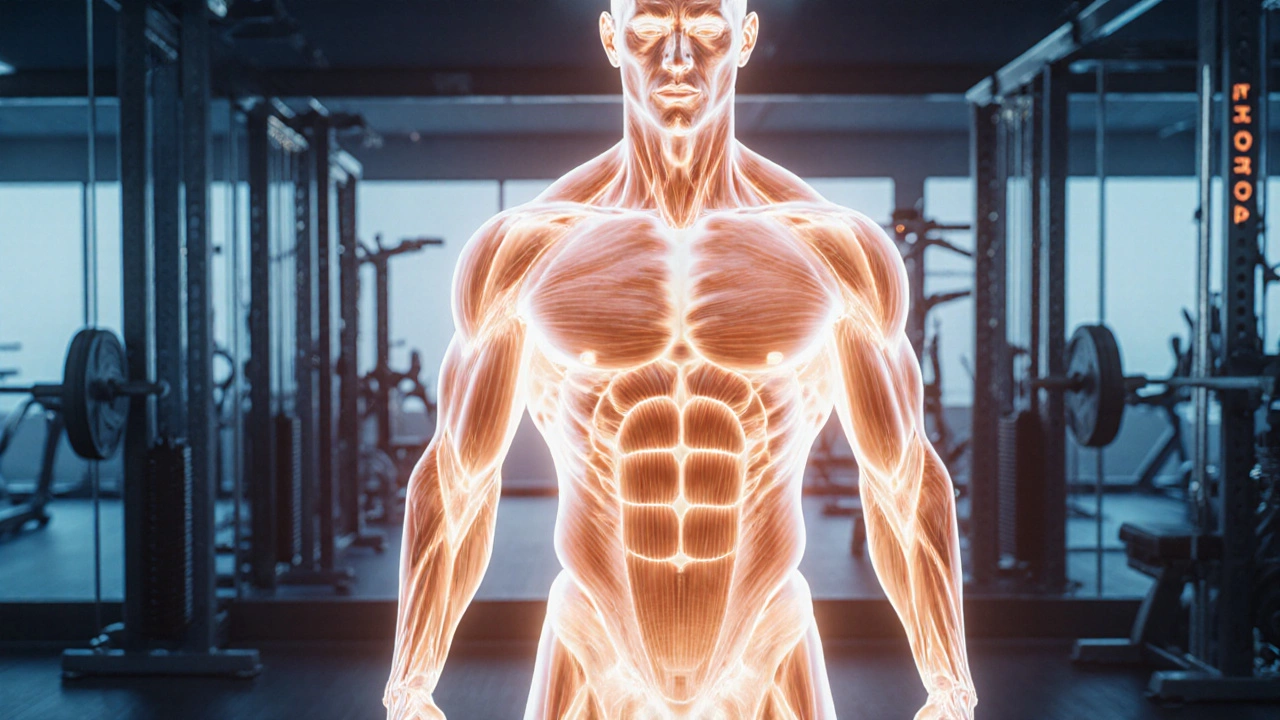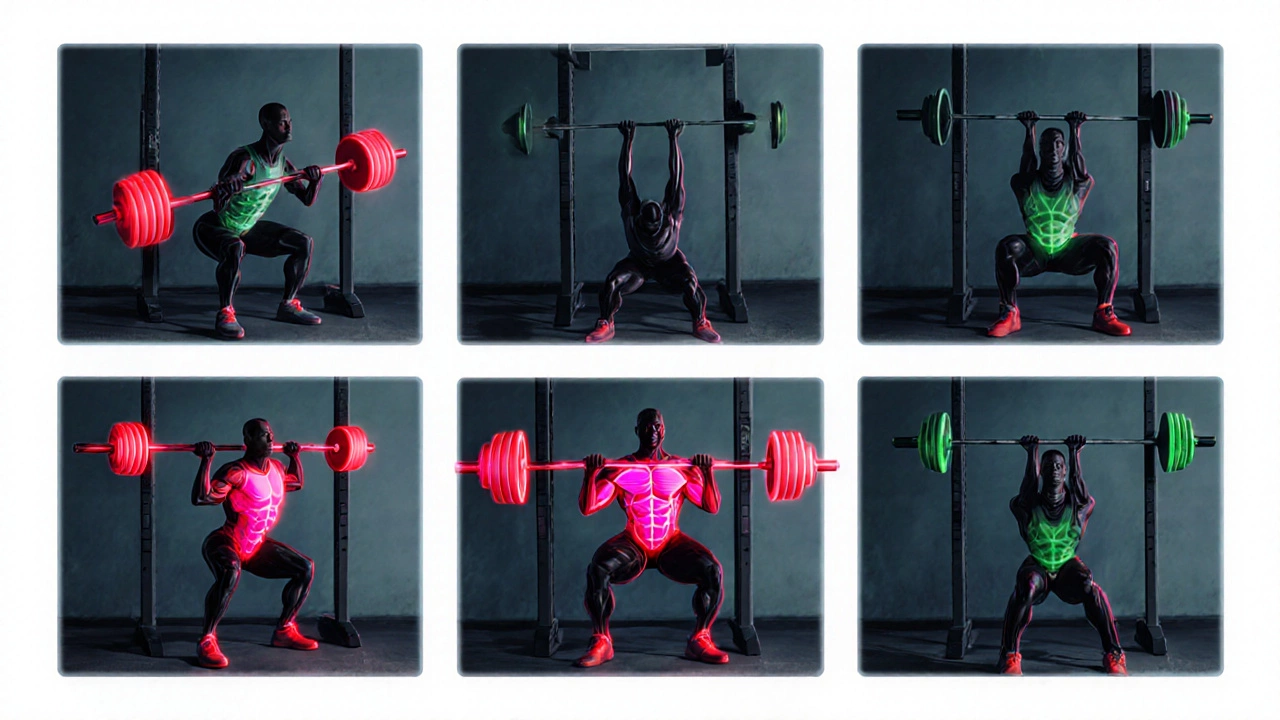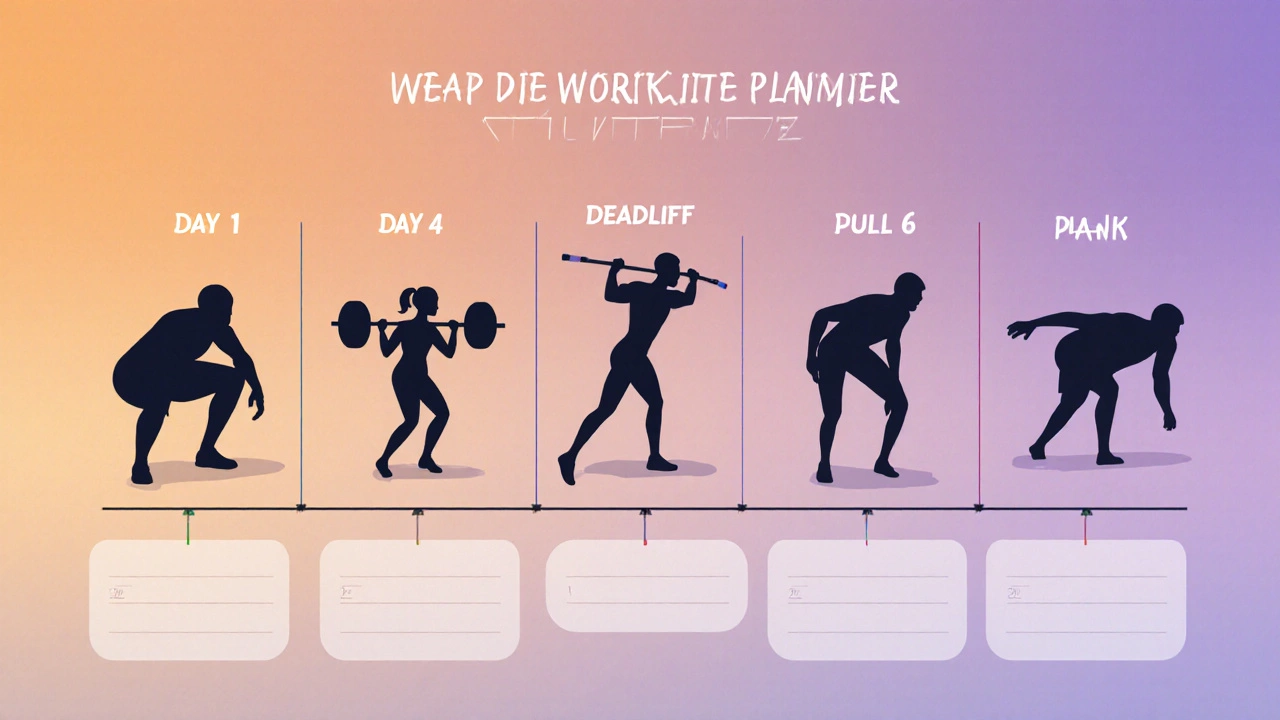Workout Muscle Mapping: Which Exercises Target Which Muscles
 Oct, 21 2025
Oct, 21 2025
Muscle Targeting Calculator
Muscle Targeting Results
When you walk into the gym, the biggest question is often "Which workout hits which muscle?" Knowing the answer lets you build a routine that actually moves the needle, instead of wasting time on moves that barely make a dent. Below you’ll find a plain‑English guide that matches the most common lifts to the primary muscles they fire, plus tips on balancing your program so every major group gets enough love.
Understanding the Basics of Muscle Anatomy
Before you can pair movements with muscles, you need a quick refresher on the major muscle groups you’ll be targeting. Most gym‑goers focus on the big‑picture names - quads, chest, back - but each group is made up of several fibers that contribute differently depending on the angle of the lift.
Quadriceps are the four‑head muscle on the front of your thigh, responsible for knee extension. They dominate movements like squats and lunges.
Chest (pectoralis major) pushes the arms forward and inward, powering presses and flyes. A well‑developed chest also aids shoulder stability.
Back (latissimus dorsi, rhomboids, trapezius) pulls the shoulders down and back, crucial for rows, pull‑ups, and deadlifts. Strong lats give you that V‑taper look.
Shoulders (deltoids) consist of three heads - anterior, medial, posterior - each activated by different pressing and pulling angles. Balanced shoulder work prevents imbalances that can hurt the rotator cuff.
Biceps are the two‑head muscle on the front of the upper arm, responsible for elbow flexion and forearm supination. They shine in curls and pulling movements.
Other noteworthy groups include the hamstrings, glutes, triceps, calves, and core muscles like the rectus abdominis and obliques. Knowing where each sits helps you pick the right lift for the right purpose.
How to Match Exercises to Primary Muscles
The simplest way to think about it is to label each lift with its "primary" muscle - the one that does the bulk of the work. Secondary muscles assist, but they’re not the main driver. Below is a quick cheat‑sheet you can print or save on your phone.
- Squat - primarily hits the quadriceps, but also engages glutes and hamstrings.
- Bench Press - primary mover is the chest, with secondary work from shoulders and triceps.
- Deadlift - targets the hamstrings and glutes, while the lower back and traps play a supporting role.
- Pull‑up - latissimus dorsi leads the pull, assisted by biceps and rear delts.
- Overhead Press - shoulders (especially the anterior deltoid) take the load, with triceps helping to lock out.
- Lunge - front‑leg quadriceps dominate, rear‑leg glutes & hamstrings help balance.
- Row (Barbell or Dumbbell) - back muscles, particularly the lats and rhomboids, are the main drivers.
- Plank - core muscles (rectus abdominis, transverse abdominis, and obliques) maintain tension.
Notice how most compound lifts cover two or three major groups. That’s why they’re the backbone of any strength program - they let you hit more muscle per minute.
Core Compound Movements and the Muscles They Hit
Compound exercises recruit multiple joints and large muscle masses, making them the most efficient way to build strength and size. Below are the top five, broken down into what you should feel working.
- Squat - Primary: Quadriceps. Secondary: Glutes, hamstrings, core. When you descend, you should feel a stretch in the quads; on the way up, the glutes fire to finish the lift.
- Bench Press - Primary: Chest. Secondary: Anterior deltoids, triceps. A solid bench press feels like a push from the chest, with the shoulders and triceps adding power.
- Deadlift - Primary: Hamstrings and glutes. Secondary: Erector spinae, traps, forearms. The initial pull is hamstring dominant; once the bar passes the knees, the glutes drive the lock‑out.
- Pull‑up - Primary: Lats. Secondary: Biceps, rear delts. Think of pulling your elbows down toward your hips rather than just using your arms.
- Overhead Press - Primary: Deltoids (especially anterior). Secondary: Triceps, upper chest. The lift should feel like you’re pushing the weight straight up, keeping the core tight.
These five cover almost every major muscle group. By rotating them through your week, you guarantee balanced development.

Isolation Exercises and Their Target Muscles
Isolation moves zero in on a single muscle, perfect for shaping lagging areas or adding volume without overtaxing the whole body. Here’s a quick list of the most effective isolations:
- Leg Extension - isolates the quadriceps. Great for upper‑quad definition.
- Hamstring Curl - isolates the hamstrings. Ideal for knee‑flexion strength.
- Cable Fly - isolates the chest. Provides a deep stretch and peak contraction.
- Face Pull - isolates the rear deltoids and upper back, crucial for shoulder health.
- Triceps Push‑down - isolates the triceps. Helpful for lock‑out power on presses.
- Barbell Curl - isolates the biceps. Simple yet effective for arm size.
- Calf Raise - isolates the gastrocnemius and soleus, building lower‑leg thickness.
- Russian Twist - isolates the obliques. Adds rotational core strength.
Use these after your main compound lifts. One to three sets of 12‑15 reps is enough to give the muscle a good pump without over‑training.
Building a Balanced Weekly Routine
Now that you know which lifts hit which muscles, the next step is structuring them. A common split that works for most intermediate lifters looks like this:
- Day 1 - Lower Body (Quad‑Heavy): Back squat, leg extension, lunges, calf raise.
- Day 2 - Upper Push: Bench press, overhead press, triceps push‑down, cable fly.
- Day 3 - Rest or Active Recovery: Light cardio, mobility work.
- Day 4 - Lower Body (Hip‑Heavy): Deadlift, hamstring curl, glute bridge, calf raise.
- Day 5 - Upper Pull: Pull‑up, barbell row, face pull, biceps curl.
- Day 6 - Core + Conditioning: Plank variations, Russian twists, high‑intensity interval training.
- Day 7 - Full Rest.
Adjust volume based on your goals - strength seekers may do 4‑5 sets of 3‑6 reps on compounds, while hypertrophy fans stick to 8‑12 reps. The key is to hit each major muscle at least twice a week for optimal growth.

Quick Reference Table
| Exercise | Primary Muscle(s) | Secondary Muscle(s) |
|---|---|---|
| Squat | Quadriceps | Glutes, Hamstrings, Core |
| Bench Press | Chest | Anterior Deltoid, Triceps |
| Deadlift | Hamstrings & Glutes | Erector Spinae, Traps, Forearms |
| Pull‑up | Latissimus Dorsi | Biceps, Rear Deltoid |
| Overhead Press | Deltoids | Triceps, Upper Chest |
| Lunge | Quadriceps | Glutes, Hamstrings |
| Barbell Row | Back (Lats & Rhomboids) | Biceps, Posterior Deltoid |
| Plank | Core (Rectus Abdominis) | Obliques, Transverse Abdominis |
Keep this table handy when planning workouts - it’s a fast way to check that you’re not neglecting any major group.
Common Mistakes and Pro Tips
- Skipping the Warm‑up: Jumping straight into heavy lifts shuts down blood flow to the target muscles. Spend 5‑10 minutes on dynamic stretches specific to the day’s focus.
- Relying Only on Machine Isolation: Machines are great for safety, but they often limit natural movement patterns. Pair them with free‑weight equivalents to build functional strength.
- Ignoring Recovery: Muscles grow while you rest, not during the set. Aim for 48‑72 hours between working the same primary muscle group.
- Bad Form Over Heavy Weight: Prioritise technique. A well‑executed squat with 70% of your 1RM beats a sloppy 100% load that strains joints.
- Neglecting the Core: A strong core stabilises every lift, from bench press to deadlift. Include planks, dead‑bugs, or farmer’s walks each session.
Remember, the goal isn’t just to lift more weight - it’s to develop a balanced, injury‑free physique that performs in everyday life and sport.
Frequently Asked Questions
Do I need to do both compound and isolation exercises?
Yes. Compounds give you the biggest bang for your buck, hitting multiple muscles and building overall strength. Isolation work fine‑tunes lagging areas, adds volume, and helps sculpt shape. A mix of 70% compound and 30% isolation works for most goals.
How often should I train each muscle group?
Aim for 2‑3 sessions per week per major muscle. This frequency balances stimulus and recovery, especially if you’re doing 8‑12 reps per set for hypertrophy.
Can I replace the squat with a leg press?
Leg presses are useful if you have knee issues, but they don’t engage the core or the posterior chain as effectively as squats. Use them as a supplement, not a full replacement.
What’s a good indicator I’m targeting the right muscle?
You should feel a distinct burn or tension in the target area during the concentric (lifting) phase. If you notice other muscles taking over, tweak your form or adjust the weight.
Is there a single exercise that works the entire body?
The deadlift comes closest - it taxes the legs, back, core, and even grip. However, no one movement can fully replace a well‑rounded program that includes vertical and horizontal pushes and pulls.
Use this guide as a living document. As you progress, you’ll discover which muscles respond best to which cues. Keep tweaking, stay consistent, and the results will follow.